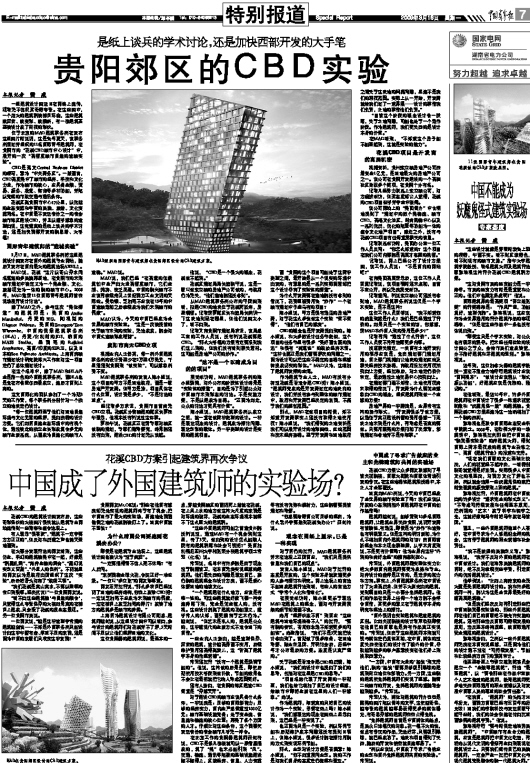Didn't plan to write about this project. I simply didn't know what to say when I first saw the images - completely speechless... A few days ago I read a series of articles on the China Youth Daily. I think it's worth to spread the messages and write down some thoughts.
This is a "city creation experiment" orchestrated by MAD. The 11 participants include Atelier Manferdini (USA), BIG (Denmark), Dieguez Fridman (Argentina), EMERGENT/Tom Wiscombe (USA), HouLiang Architecture (China), JDS (Denmark/Belgium), MAD (China), Mass Studies (Korea), Rojkind Arquitectos (Mexico), Serie (UK/India), Sou Fujimoto Architects (Japan). Each of them got a piece from the master planner and designed a building for this wacky new "city center" in the middle of beautiful terraced fields outside Guiyang, the biggest city in Guizhou Province, China. An amazing group of talents, but sadly, the result is just a bunch of monsters dancing in the middle of nowhere...




I don't want to get into the whole "foreign-architects-experimenting-in-China" phenomenon. I don't think it's essentially a bad thing for a country where the title "architect" only exists for 30 years. But in this particular case, there are three points I want to make:
Floating Architecture
Rome was not built overnight. Nor can a CBD be planted everywhere. By definition, you need a lot of "business" going on in a CBD, which means a high density of population and activities, immense economic basis, and infrastructure support. These don't come out of thin air. Huaxi is a rural area 17 kilometers away from Guiyang - the capital city of Guizhou Province, which is one of the less developed provinces in the southwest part of China and famous for its natural landscape. Intense development here sounds very unpractical. As Luo Songhua, deputy head of Huaxi District said, "CBD is a big concept. Huaxi can't afford it." Who will put their headquarters over here?
In fact, everything is really just up in the air. The project was launched by a private developer (Homnicen Group) and the city knows nothing about it. The developer hasn't even got the land yet. When asked about the feasibility of a CBD in Huaxi, MAD's response was "This is not our business - not within our scope of work. We just take the survey maps from the developer and design within the assigned boundaries." So the architects' vision is just framed by the site boundary and never goes beyond that? Nobody wants to take on broader social responsibilities and go through a feasibility study? They are doing their little things with the windows shut instead of committed actively to reality. Whatever manifestoes they are trying to make are merely hollow big talks, floating with no solid grounds.
Billboard Architecture
Homnicen Group is said to be the biggest local developer. When the journalist tried to verify with them if this is just theoretical proposal, the response was "Think about this. If this is just an experiment, who pays the fee for MAD and all those foreigners?" Maybe it's not entirely hypothetical. Maybe the developer just wanted to put on a show and promote the deal? This certainly has been a successful business model. Architects are cheaper than movie stars anyways! Even politicians know the advertising value of fancy designs. See how much Bilbao made out of Frank! Architects seems to be enjoying the situation as well. Fuck the ethics of architecture. I'll paint your billboard, as long as I get paid!
Back to our own business. How about architects advertising themselves? How can you catch the eyes and get instant fame? Do something weird! Something people never saw before! All of a sudden, new things are created just for the sake of being new. Architecture is all about catchy imagery. Who cares if it can ever get built? Who cares what it does to society? It can always go to China or Dubai! (Sorry, not sure now.)
Hard Drive Architecture
We used to call those unbuilt experimental projects "paper architecture" because they just stay on paper. Now we should call them "hard drive architecture" because they only exist as a bunch of binary codes. For paper architecture, you still need to drawing every single line and color every single patch. That allows time for consideration and there were thinking involved. With new technologies, everything happens so fast and you don't even need to think. The computer does it for you!
MAD insists the goal for this experiment is not construction. "Concepts getting developed into drawings, this is already a way of realization." I do believe in the value of experimental designs. Back in the good old 60s, Archigram's fantastic collages contained so many thought-provoking elements. There are so many dimensions to it. In the discourse of architecture, they are of equal significance compared to built works, if not more. But now look at this bunch in Huaxi. Where is the social agenda? What does a computer rendering of alien invasion provoke? They are criticizing the "soullessness" of Manhattan and Chicago (is it true?) but are these monsters full of life? Maybe the biggest value of this whole thing is that it's so bad that it makes people reflect... OK, it makes me write. That's worth something.
References:
Dezeen post (EN)
China Youth Daily article on Sina (CH)

1 comment:
Agree!
Post a Comment